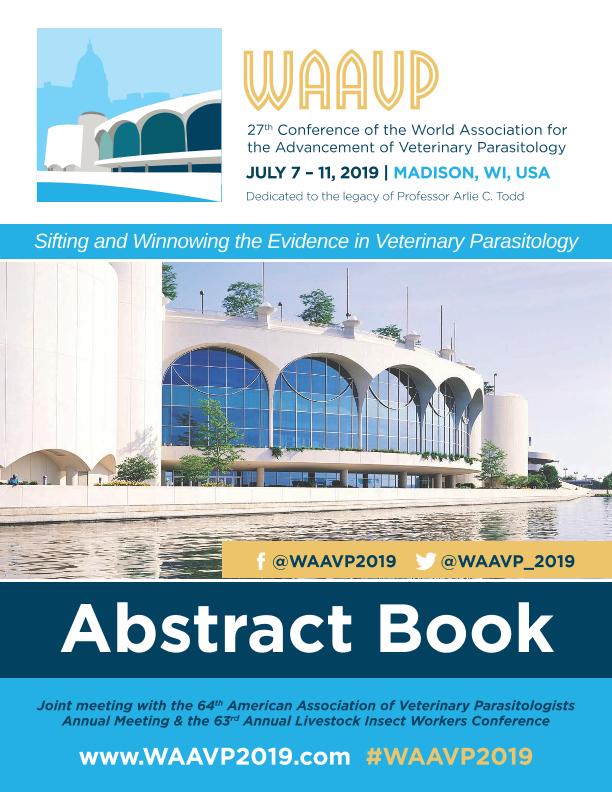Evento
Effect of different concentrations of anthelmintics on mycelial growth of the biological control agent duddingtonia flagrans
Zegbi, Sara ; Saumell, Carlos Alfredo; Sagüés, María Federica
; Saumell, Carlos Alfredo; Sagüés, María Federica ; Ceballos, Laura
; Ceballos, Laura ; Guerrero, Ines; Iglesias, Lucía Emilia; Fernández, Alicia Silvina
; Guerrero, Ines; Iglesias, Lucía Emilia; Fernández, Alicia Silvina
 ; Saumell, Carlos Alfredo; Sagüés, María Federica
; Saumell, Carlos Alfredo; Sagüés, María Federica ; Ceballos, Laura
; Ceballos, Laura ; Guerrero, Ines; Iglesias, Lucía Emilia; Fernández, Alicia Silvina
; Guerrero, Ines; Iglesias, Lucía Emilia; Fernández, Alicia Silvina
Tipo del evento:
Conferencia
Nombre del evento:
27th Conference of the World Association for the Advancement of Veterinary Parasitology
Fecha del evento:
07/07/2019
Institución Organizadora:
World Association for the Advancement of Veterinary Parasitology;
Título del Libro:
Abstract Book: 27th Conference of the World Association for the Advancement of Veterinary Parasitology
Editorial:
World Association for the Advancement of Veterinary Parasitology
Idioma:
Inglés
Clasificación temática:
Resumen
Duddingtonia flagrans acts as biocontrol agent by preying on pre-parasitic nematode larvae in animal faeces. This fungus could be exposed to anthelmintic drugs eliminated in faeces, but little is known as to whether these drugs could alter the fungal development and its efficacy. Thus, the aim of this study was to determine the in vitro effect of certain anthelmintics on the growth of this fungus. In two assays, active ingredients diluted in methanol of the five anthelmintic drugs most commonly used in Argentina were used in concentrations reported as found in bovine faeces: levamisole, 1 ppm; albendazole, 0.027, 0.054 and 1 ppm; fenbendazole, 0.027, 0.054 and 1 ppm; ricobendazole, 1 and 2.77 ppm; ivermectin, 1, 2 and 10 ppm. Each of these drug concentrations were added to corn meal agar (CMA) 2% and then poured on Petri dishes (n=12/concentration). Plates with CMA and containing only methanol and only D. flagrans were used as control. All plates were inoculated with 1 cm2 of fresh D. flagrans mycelia growing in CMA, and incubated at 27ºC for 7 (assay 1) or 12 (assay 2) days. The fungal growth rate was determined every 24 h by measuring the radial growth. Similar fungal growth was obtained from the control plates containing only D. flagrans (6.79 to 8.12 mm/d), only methanol (6.5 to 7.17 mm/d), levamisole (6.49 to 6.99 mm/d) and both concentrations of ricobendazole (6.51 and 7.53 mm/d). Ivermectin slowed significantly (P=0.0181 ? P=0.0351) the fungal growth in all tested concentrations (6.14, 5.67 and 6.29mm/d). Albendazole reduced the mycelial growth only at 1 ppm (0.89 mm/d, P<0.0001), while fenbendazole affected negatively the fungal growth in all concentrations (0.46 to 2.19 mm/d, P<0.0001). These results represent a first step on elucidating whether anthelmintics could be used in very specific situations while biological control is applied.
Archivos asociados
Licencia
Identificadores
Colecciones
Eventos(CIVETAN)
Eventos de CENTRO DE INVESTIGACION VETERINARIA DE TANDIL
Eventos de CENTRO DE INVESTIGACION VETERINARIA DE TANDIL
Citación
Effect of different concentrations of anthelmintics on mycelial growth of the biological control agent duddingtonia flagrans; 27th Conference of the World Association for the Advancement of Veterinary Parasitology; Madison; Estados Unidos; 2019; 1-2
Compartir



